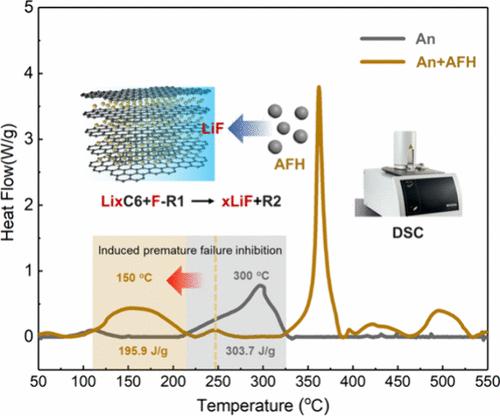Anode Failure Hunter with a Self-Quenched Function Boosting Lithium-Ion Battery Safety
IF 18.2
1区 材料科学
Q1 CHEMISTRY, PHYSICAL
引用次数: 0
Abstract
Safety issues significantly influence the iterative application of lithium-ion batteries (LIBs), and they have become a critical challenge that requires immediate resolution. Herein, a new type of self-quenched battery with an anode failure hunter was developed in which a high flame retardant was utilized to react with the LixC6 of the anode, making it ineffective at a temperature range of 90–120 °C, avoiding its reaction with the oxygen produced by the cathode and blocking the occurrence of a large scale chain exothermic reaction (O2 + LixC6). After the anode failure hunter was assembled as a self-quenched battery, the onset temperature of the self-quenched battery was increased by 15.5 °C, improving battery safety from the intrinsic level. More importantly, the energy release of the thermal runaway for the self-quenched battery has been reduced by 123.7 °C, significantly improving the safety of the battery. Therefore, such work could provide a new strategy to design devices for solving the safety issue in LIBs.

具有自淬功能的阳极故障猎人提高锂离子电池的安全性
安全问题严重影响锂离子电池(lib)的迭代应用,并已成为一个迫切需要解决的关键挑战。本研究开发了一种新型阳极失效猎人自淬电池,利用高阻燃剂与阳极的LixC6发生反应,使其在90-120℃的温度范围内失效,避免了与阴极产生的氧气发生反应,阻止了大规模链式放热反应(O2 + LixC6)的发生。将阳极失效猎人组装成自淬电池后,自淬电池的起燃温度提高了15.5℃,从本质上提高了电池的安全性。更重要的是,自淬电池热失控的能量释放降低了123.7℃,显著提高了电池的安全性。因此,这项工作可以为解决lib中的安全问题提供一种新的设计策略。
本文章由计算机程序翻译,如有差异,请以英文原文为准。
求助全文
约1分钟内获得全文
求助全文
来源期刊

ACS Energy Letters
Energy-Renewable Energy, Sustainability and the Environment
CiteScore
31.20
自引率
5.00%
发文量
469
审稿时长
1 months
期刊介绍:
ACS Energy Letters is a monthly journal that publishes papers reporting new scientific advances in energy research. The journal focuses on topics that are of interest to scientists working in the fundamental and applied sciences. Rapid publication is a central criterion for acceptance, and the journal is known for its quick publication times, with an average of 4-6 weeks from submission to web publication in As Soon As Publishable format.
ACS Energy Letters is ranked as the number one journal in the Web of Science Electrochemistry category. It also ranks within the top 10 journals for Physical Chemistry, Energy & Fuels, and Nanoscience & Nanotechnology.
The journal offers several types of articles, including Letters, Energy Express, Perspectives, Reviews, Editorials, Viewpoints and Energy Focus. Additionally, authors have the option to submit videos that summarize or support the information presented in a Perspective or Review article, which can be highlighted on the journal's website. ACS Energy Letters is abstracted and indexed in Chemical Abstracts Service/SciFinder, EBSCO-summon, PubMed, Web of Science, Scopus and Portico.
 求助内容:
求助内容: 应助结果提醒方式:
应助结果提醒方式:


